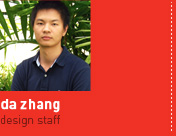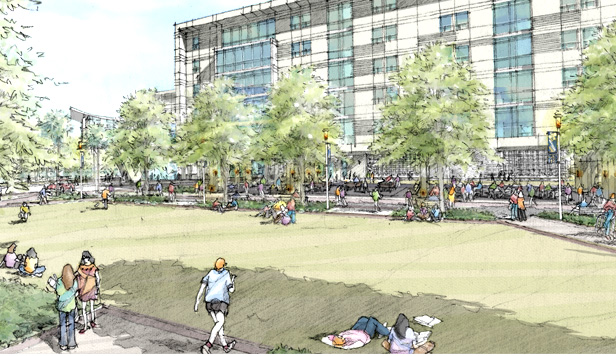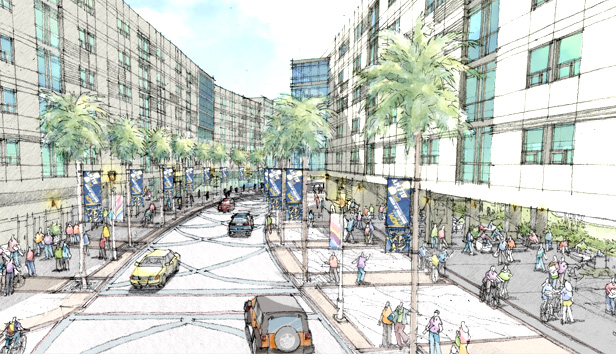



Today's complex environment requires that we constantly re-adjust our mindsets by responding appropriately to changes as they occur. As problem solvers, this is where design thinking and innovation play a significant role. It's about grasping incremental changes in technology, science and society and converting those changes into ideas, concepts and ultimately places that get people excited. It's not about saying yes to everything. It's about saying no to all but the most crucial of elements.
At EDSA we view innovation as shaping positive change. One could say increasing the lifespan of a battery or the ability to convert refuse to a new energy source is positive change. But on the most basic level, innovation begins by simply identifying a problem and seeing an opportunity. In this context, innovation drives our approach to creating a sustainable future.
Sustainability is a fundamental part of the challenges that face every industry today. Planning and design are at the forefront of resolving how the need to consume can be offset with the need to be good stewards of our planet. It's about addressing and resolving how businesses can deliver a superior experience while reducing waste and carbon footprint. In the long-term, solutions must be ambitious and feasible for implementation. Otherwise, the potential benefits are limited.
While EDSA's design philosophy has evolved over several decades, it has always been based on a human-centered approach. As design innovators, we first examine who we are designing for, then formulate an appropriate, yet fresh and creative design solution. Finally, we explore new methods of implementation. The resulting measure of success is directly related to the value it brings real users in their everyday lives.
Take a look at any of the top global brands – consider Coca-Cola, Apple, and GE, among others. It's no accident that many of them are also considered design leaders. Design is a fundamental part of creating an image and experience of luxury, exclusivity and belonging. We believe that design thinking must begin with empathy and that the major context for any innovative effort lies in understanding the needs of your user.
The most effective means to garner an understanding is through direct observation. Rather than simply listening, it is important to observe what, why and how people are actually doing things. How are they using and enjoying the spaces you have in existence? This direct correlation develops a point of view and provides inspiration for ideas. Why? Because it assumes that the people who will ultimately become the idea's users are always central to how it is developed.
In turn, design thinking must not only synthesize functionality and aesthetics, it must represent thought processes and emotions. Design innovation means no longer designing previously specified programs, but deciding what processes, products and/or systems are needed for the users. The underlying premise is that people don't just buy utility, they buy emotion and symbol. For the average person, choices are made by balancing the need for evolution with the force of habit. Finding the proper symmetry, well, that's the essence of innovation.
Leading companies listen to consumers, employees and investors and respond to the messages they receive. They want to know how people really feel, they gather input and use it to drive innovation and they realize that there is a lot to be learned from the wisdom of crowds. Likewise, great designers create value by exploring without limitation. They assemble teams of individuals who see the world through different eyes and ascertain what should be as opposed to what is. They show discipline in doing more with less. By combining forces, we can create new business opportunities and pathways to manifest consumer needs, emotions and aspirations. For more information contact us directly at 954.524.3330 or info@edsaplan.com.

Aggressive and progressive best define the Behling Studio. This talented group of designers has a creative chemistry that allows them to work fluidly and seamlessly with a confidence to move projects forward. They begin each assignment with an imagination workshop where all ideas are viable, free form designs are welcome and discovery is the result of a series of pen strokes. This creative flexibility and removal of design boundaries enables the team to gain a deeper understanding of the complexities and implications of a project resulting in an organically developed program.
"For me, it's about giving people opportunities to go places and do things. Each person must develop a personal reference bank that they can draw upon for cultural and social
inspiration. It's only through continuous learning, that designers can better understand how experiences add to place." - Bob Behling, FASLA, Principal.
With current projects in six different countries, the Behling Studio is credited for establishing long-term relationships with clients that trust them unequivocally. These connections are attributed to their extreme responsiveness, taking client deadlines seriously and an unmatched quality of deliverables. Their energy and creativity has sparked numerous referrals, bringing to their repertoire projects such as the soon to be built Four Seasons in Dubai and Bahrain, and the Dubai Opera House, as well as recurring involvement with the Atlantis brand in Paradise Island, Dubai and most recently the Hainan Resort in China.
For more information on the Behling Studio visit http://www.edsaplan.com/en/Team/Studios/Behling

As a young boy in China, Da Zhang enjoyed sketching and recreating imagery from travel guides and coffee table books to capture the expression of distant places and immerse himself into diverse cultures. He received an urban planning degree from Huazhong Agricultural University and earned a master's in landscape architecture from the University of Georgia. In between his studies, he travelled around Europe and was inspired by the small town of Luzern, Switzerland with its picturesque landscapes and tranquil outdoor spaces. This experience ignited his passion to create places that not only make sense but generate positive environments and enjoyable memories. As a member of the Smith Studio, Da's favorite project is always the one he gets to work on next. His remarkable skills of incorporating new technology with traditional design techniques add detail, aspect, scale and efficiency. His talent with SketchUp is complimented by his realistic approach of always designing in three dimensions. |

An evolution of opinions, experiences, perceptions and styles have shaped François Verhoeven. Practicing for about 10 years, he recognizes that design reaches beyond beautiful drawings – it's about coming up with a concept and an implementation plan that is believable, realistic, do-able and multi-dimensional. His exposure to the construction aspect of projects has made him a candid designer with a sincere interest in how land uses shape our physical environment. A native of Belgium, bilingual, with family ties in several countries, François is able to integrate a multi-cultural perspective into everything he does. His artistic aptitude reaches beyond his professional practice, as a classical pianist and a fascination for visual animation; François is drawn to the creation of movement. He enjoys the camaraderie and team collaboration his work brings and finds solace in applying this thought sharing process. François is currently a member of the Larrea Studio working on several projects in Latin America. |

Derick Cissel, a graduate of West Virginia University, is currently a member of the Orlando Studio and during his ten years with EDSA has spent time in the Fort Lauderdale office as well as six months at EDSAOrient Beijing, our joint venture. Most proud of his design acumen, Derick's out-of-the-box thinking brings a fresh approach and creative perspective to all assignments. With an admiration for all design forms, Derick finds inspiration in the works of renowned Spanish architect, Santiago Calatrava, appreciating his organic style and bold expressions. By marrying details and culturally appropriate form with a passion for sustainability and utility, Derick's designs yield the best guest experience while addressing clients' wishes. He is very excited to have influenced the design of the Four Seasons Orlando, envisioned to be the largest Four Seasons resort globally, and a legacy project for |




As Miami's first and only urban public research university focused on student learning, innovation and collaboration, Florida International University (FIU) is positioning itself for continued growth. With a current enrollment of 50,000 students, FIU like many universities around the globe is addressing the growing need for on-campus housing and the increased awareness by students and administrators that residential accommodations have become a big factor in college selection.
With one of their primary missions to grow the on-campus experience, FIU is undertaking an expansion of their student housing offerings. Upon completion, Parkview will provide residences for more than 1,200 students. This housing facility is a collaboration between Housing and Residential Life and the College of Law. As a Living Learning Communities (LLC), students will benefit by residing with others who share similar interests and their education major affording them the opportunity to interact with faculty and staff mentors who are committed to helping law students succeed.
Set to open this fall, Parkview Phase One envisions 600 residents in 40-student housing clusters referred to as a residential community. Phase Two is scheduled for completion by fall 2016. Along with the dorms, the two new buildings, connected by an elevated bridge, will include community lounges, study rooms and state-of-the-art multi-purpose gathering spaces as well as many other outdoor social areas to accommodate residential life programs and activities. Each apartment is fully-furnished and air conditioned with a shared bathroom, full kitchen, living room, Wi-Fi, cable, laundry room and what may seem trivial to some, a full size mattress. Additionally, this is the very first housing project at FIU that will have its own parking structure. The 3-story parking garage will be placed between Parkview and Panther Hall.
Comprised of the East Tower, West Tower and Short Wing and positioned directly adjacent to the football stadium, the design layout for Parkview resembles a town form environment with pedestrian streets, covered walkways, outdoor seating areas, green spaces, retail and other amenities. Emphasis has been placed on design solutions that foster student interaction and social activity, while placing priority on safety and security. The green spaces between the buildings will enhance the student experience and ensure access to outdoor areas for recreation, congregation and physical activity. With a concentrated effort on maintaining its 3-year, first place ranking in the State University System of Florida for energy conservation and sustainability, Parkview will be a LEED built project with a Silver Certification.
EDSA's involvement began with site selection and analysis of the opportunities and constraints related to location of the new residence hall. Alternative concepts were evaluated and diagrammatic site plans illustrated the relationship between components and addressed phasing options. Through detailed design courtyards, arrival sequences and pedestrian walkways were refined. Specifics for plantings, paving, irrigation, lighting, site furnishings, retaining walls and signage elements were also finalized. EDSA is currently providing construction administration services and continues to guide the implementation of the project to ensure design quality and adherence to the University's standards for stewardship in design.

Creative Village is transforming the former Amway Arena site into a 68-acre mixed-use,
transit-oriented, urban infill neighborhood in the heart of downtown Orlando. The project is envisioned to create a true “live, learn, work, and play” city destination with a synergistic and dynamic mix of office/creative studios, education, residential, retail/commercial and hospitality programming.
Upon completion, this highly sustainable neighborhood will be the largest transit-oriented development project in Central Florida. A job creation study estimates an additional 6,500 jobs during the construction period and more than 8,000 total Creative Village related jobs in the local economy at build-out. Additionally, Creative Village will showcase best practices in responsible development and will be the largest LEED-ND development in Florida.
Demolition of the Amway Arena is complete and construction is expected to begin this summer on the neighborhood street grid as part of the Phase I ground-level improvements. Vertical development is anticipated to begin in 2014.
For more information visit: www.creativevillagedevelopment.com

If visiting Tokyo, one must take at least a half-hour stroll through Chinzan-Sō Garden, taking in the dramatic colors that contrast the modern lines of the nearby financial center. This lovely, hilly 66,000 square meter strolling garden was part of the estate of a Meiji-era politician and statesman. Once inside this tranquil oasis, you can't help but admire the crafted knolls, ponds, waterfalls and flower gardens. Lining its many pathways is a number of antiquities brought from all over Japan. Most notable is a stunning 16.7 meter, three-story pagoda, estimated at nearly a millennium old, which was transported from the Hiroshima area, as well as lanterns, monuments and torii. The natural beauty of Chinzan-Sō is so refreshing because not only do you connect with nature but you are engulfed by Japan's rich culture and history.

The University of Florida honored David S. Armbruster, FASLA with the 2013 Distinguished Landscape Architecture Service Award for his substantial contribution of time and service to the education and body of built landscape architecture works. David Armbruster joined EDSA in 1963 and during his extensive career has directed the planning and design efforts for a variety of large, complex land developments in the Caribbean, Mexico, Spain, Portugal, Russia, New Zealand, South America and the United States. Mr. Armbruster retired from EDSA in 2011 but continues to promote the profession and the firm through lectures, design reviews and community outreach.









